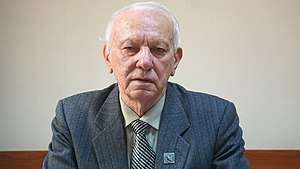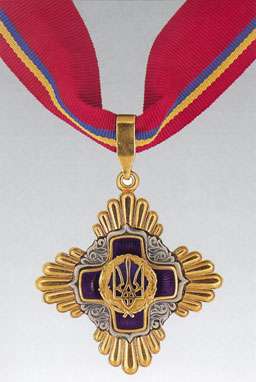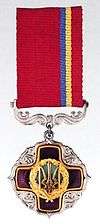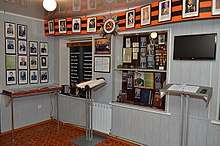Roman Shvartsman
| Roman Shvartsman | |
|---|---|
 Roman Shvartsman in his office | |
| Born |
Shvartsman Ruvin Mordkovich November 7, 1936 Ukraine, Bershad city |
| Nationality | Ukrainian |
| Citizenship | Ukraine |
| Alma mater | Odessa National Maritime University |
| Occupation |
|
| Home town | Odessa |
| Awards |
   |
Roman Markovich Shvartsman (born November 7, 1936) is chairman of the Odessa regional Association of Jews – former prisoners of ghetto and Nazi concentration camps.[1]
He is Vice President of the Ukrainian Association of Jews - former prisoners of ghetto and Nazi concentration camps, and Chairman of the Association of Boris Zabarko.[2][3]
He is also Deputy chairman of the Council of Odessa society of Jewish culture and Manager of its social and cultural center.[4]
Biography

Roman Markovich Shvartsman was born in 1936, in a simple Jewish family in the city of Bershad, Vinnytsia region. The family had nine children, the seventh of whom was Roman Shvartsman. His mother was a housewife, his father worked at the Bershad distillery as a security guard. When the Second World War ended, all archival and personal documents were burned and then, to restore the age of the Roman, a doctor of the local clinic was conducted by an external examination.
In 1955, he moved to Odessa, where he entered the vocational school № 2, in 1956, he received a specialty fitter. From 1957 to 1963 he studied at the Odessa National Maritime Academy, with a speciality as engineer-mechanic.
Roman began his career at the Odessa plant Poligrafmash,[5] where he works now. There is only one entry in his workbook.
In 1959, Roman married.
In 1992 Roman became a member of the international organization of former ghetto prisoners and concentration camps, which was founded in Odessa in 1991.
Currently, he remains a permanent and active member of the organization. In 1991, at the first Congress, the members of the international organization decided to create a regional Association of former prisoners of ghettos and concentration camps, and the headquarters of the international Union was moved to Moscow.
In 1991 the Odessa regional Association of the former prisoners of the ghetto was created, where Roman was Deputy Chairman, which at that time was Leonid Sushon.[6]
In 2002, at the Odessa regional conference, dedicated to the results of the Association, Roman was elected Chairman of the Association, the head of which he is to date.
He contributes to the annual festive events, in the Prokhorovsky square, dedicated to the International day of remembrance of the victims of the Holocaust,[7] which the whole world celebrates on January 27. The International day of liberation of concentration camp prisoners is celebrated annually on April 12, as well as holding events on the topic of the Holocaust at the Jewish cultural center «Beit Grand», educational activities in schools, universities and on television. He is a guest of honor at conferences on an international level, dedicated to the topic of the Holocaust.[8]
He is actively involved in the development and improvement of the Museum Holocaust's,[9] which was created and opened by the Association of prisoners in 2009.
Memories of the Holocaust
In 1941 the whole of Ukraine was occupied by German and Romanian troops. In the early days of the outbreak of war Roman's father and older brother went to the front. In early July, his mother, with her eight young children, tried to evacuate. After two weeks attempts at evacuation, they were forced to return home, because of active offensive fascist troops.
In late July, early August in Bershad the Germans came. And in early September by the decree of the commandant of the German administration, two ghettos were organized in the territory of the city, in one of which was Roman's family.[10][11]
In the Bershad ghetto Jews were deported from Bessarabia and nearby areas of the Vinnytsia region.[12]
The total number of Jews amounted to 25,000 people. For the period from June 1941 until March 1944 German and Romanian fascists killed 13,871 Jews.[13]
During the occupation in 1942, an operation on repair of the bridge across the river Dohno, at the hands of Romanian caretakers one of Roman's older brothers was shot. Slightly later this history formed the basis of one of the films of the Israeli film director Boris Maftsir.[14]
Intolerable living conditions in the ghetto has left its mark for life.
On March 29, 1944 the city of Bershad was liberated by the Red Army.
In 1945, after the liberation of Europe from the fascist plague, the Roman's father was mobilized from Berlin for the war. He returned home only in 1946, after the Red Army defeated fascist Japan.
Roman's elder brother, who went to the front, did not returned. And only in 1953, the family received a death notice that he died heroically on the Northern front, defending Leningrad. His name is recorded in the "Black book". Workbook authors Vasily Grossman, Ilya Ehrenburg.[15]
Rewards
- The Order "For merits" of 1rd degree[16]
- The Order "For merits" of 2rd degree[17]
- The Order "For merits" of 3rd degree[18]
- The Order for labour distinction
- The Order "The Deserved machine engineer"
- Mark of distinction in front of Odessa
- Jubilee medal for the State and International merit
Public activity
Odessa regional Association of former ghetto prisoners and concentration camps
In Odessa the first constituent Congress was created, in which was created the International Union of Jews - former prisoners of ghettos and Nazi concentration camps. And only a few years later such associations opened in Kiev and Moscow.
In 1991 the Odessa regional Association of the former prisoners of the ghetto and concentration camps was created.[21]
The main purpose of the Association is to unite Jews-former prisoners of the ghetto and Nazi concentration camps, during the Second World War, protect their rights and freedoms, coordinate the activities of the associations, located on the territory of Odessa and Odessa region. The objectives of the Association: countering fascism, extremism and other manifestations of racial discrimination, identification of places of mass destruction of Jews during the Second World War, perpetuating the memory of genocide victims, perpetuation and search of people, saving Jews, in order to grant them the title of Righteous among the Nations of the world.
Monuments to the victims of the Holocaust
Particular mention should be made of the activities of the Chairman of the Odessa regional organization of former prisoners of ghetto and concentration camps, Roman Shvartsman: through his efforts it became possible to establish in Odessa, the Odessa region and Nikolayev region area more than thirty monuments and memorials, dedicated to the memory of Jews, destroyed in the Disaster.[22]
In memory of the victims of the Holocaust on the Lustdorf road, 27 a Memorial complex was built; each year on 23 October a mourning rally occurs.[23][24]
In this place was found three additional sites with remains, and probably there are two more. Romanian and German occupiers burned 25,000 Jewish children, women, and elderly people.[25]
As Roman Schwartzman commented:»[26][27]
«Anywhere you dig, you'll find bones-teeth and skulls and it's terrible»
In Prokhorovsky Square, on the site of the Holocaust memorial (road of death), created by the prisoner of the Bogdanovka ghetto, Yakov Maniovich,[28] under the guidance of Roman Shvartsman events are constantly held for the care of monuments and the alley of the Righteous Among the Nations.[29]
In 2016 in the town of Balta, on central square the memorial to the victims of the Holocaust was opened, a memorial to the victims of the Holocaust and the Righteous of the Nations of the world, including Queen Elena of Romania.[30]
The monuments are also open in the village of Domanevka, Bogdanovka village, in the city of Belgorod-Dniester, in the city of Savran, the city of Tarutino[31] and many others settlements of the territory of Transnistria.[32]
According to Roman Shvartsman, about 240,000 Jews were killed by the Nazis in the territory of Transnistria. In 2015 in the village of Gvozdavka 2[33] a mass grave was discovered with the remains of about 3,500 Jews.[34] Later a memorial sign was placed there.[35]
In an interview with the Associated Press, Roman Shvartsman said:[36]
«There are several thousand Jews executed by the Nazis»
The creation of a Museum of the Holocaust

The official opening of the Holocaust Museum in Odessa took place on June 22, 2009.[37]
The Chairman of the Association of former concentration camp prisoners and ghetto, Roman Shvartsman noted:[38]
«This Museum should become a school, university for young people, for them to understand, what is the Holocaust»
For the time being the Museum presents more than 4,000 exhibits. A few years after the opening, the Museum was visited by about 20,000 people from around the world: ambassadors, diplomats, leaders of the city and region, students and schoolchildren and just people, who remember or want to know about that terrible tragedy, which is called the Holocaust.
See also
References
- ↑ Kostyantyn, Federov. "The day of liberation of Odessa from fascist invaders and World day the memory of prisoners of ghetto and nazi concentration camps". Retrieved 21 March 2018.
- ↑ "Book presentation Rafail Nakhmanovich and Boris Zabarko in Dnepropetrovsk". DJC. Retrieved 22 March 2018.
- ↑ "Boris Zabarko". Dittrich Verlag. Retrieved 22 March 2018.
- ↑ Dolomanji, Antonina (27 January 2017). "A former ghetto prisoner from Odessa: "Our entire world has been limited to barbed wire»". Odessa Media. Retrieved 22 March 2018.
- ↑ "Poligrafmash, Odessa plant". Business Info. Retrieved 22 March 2018.
- ↑ Taubkin, David. "First (constitutive) the Congress of former prisoners of ghetto and nazi concentration camps". All-Israel Association " Survivors of concentration camps and ghettos". Retrieved 22 March 2018.
- ↑ "Holocaust victims' memory honored in Odessa". Official site of Odessa city. Retrieved 22 March 2018.
- ↑ Mikhailovsky, V. "The Memory Of The Disaster" (PDF). Netzulim. Retrieved 22 March 2018.
- ↑ "Will be in Odessa the Museum of memory of victims of the Holocaust". GLAS. Retrieved 22 March 2018.
- ↑ LISOVA, NATASHA. "In Ukraine, Mass Grave Found Of Jews Killed in Holocaust". The New York Sun. Retrieved 22 March 2018.
- ↑ "Mass Grave Believed to Contain Thousands of Jews Killed by Nazis Found in Ukraine". Fox News. Retrieved 22 March 2018.
- ↑ "Pipeline workers find mass grave of Jews killed by Nazis". The Guardian. Retrieved 22 March 2018.
- ↑ Dodik, Semyon. "The fate of the Transnistrian Jews". All-Israel Association "Survivors in Concentration Camp and Ghetto". Retrieved 22 March 2018.
- ↑ Sdobnov, Sergey. "13 documentary and feature films about the Holocaust". Meduza. Retrieved 22 March 2018.
- ↑ "Black book". Publishing house Corpus. Retrieved 22 March 2018.
- ↑ Vygodsky, Andrey (15 September 2018). "Roman Markovich Shvartsman was awarded the Order of Merit for the first degree". NEWSPAPER "PUBLIC SURROUND". Retrieved 17 September 2018.
- ↑ Dolomanji, Antonina. "A former ghetto prisoner from Odessa: "Our entire world has been limited to barbed wire»". Odessa news. Retrieved 22 March 2018.
- ↑ "AWARDS MEMBERS OF THE ASSOCIATION" (PDF). Chabad Odessa. Retrieved 22 March 2018.
- ↑ "On the occasion of the 80th anniversary head of the Association of former ghetto prisoners Roman Shvartsman was awarded the honorary prize of Odessa". News Mir. Retrieved 22 March 2018.
- ↑ "On the occasion of the 80th anniversary head of the Association of former ghetto prisoners Roman Shvartsman was awarded the honorary prize of Odessa". Official site of Odessa city. Retrieved 22 March 2018.
- ↑ "History of creation". ODESSA REGIONAL ASSOCIATION OF JEWS — FORMER PRISONERS OF GHETTOS AND CONCENTRATION CAMPS. Retrieved 22 March 2018.
- ↑ Steinman, Michael. "International conference, dedicated to the 65th anniversary liberation of prisoners from ghettos and concentration camps in nazi-occupied territory". All-Israel Association "Survivors in Concentration Camp and Ghetto". Retrieved 22 March 2018.
- ↑ Vaynblat, Semyon. "Sad anniversary" (PDF). Good Deed. Retrieved 22 March 2018.
- ↑ Vaynblat, Semyon. "Sacred memory" (PDF). Good Deed. Retrieved 22 March 2018.
- ↑ "Pipeline workers find mass grave of Jews killed by Nazis". The Guardian. Retrieved 22 March 2018.
- ↑ "Hololocaust grave site in Ukraine not protected". NBC News. Retrieved 22 March 2018.
- ↑ LISOVA, NATASHA. "Jews Want Control of Grave in Ukraine". Washington post. Retrieved 22 March 2018.
- ↑ Zauder, Pavel. "ODESSA. THE DARK DAYS OF THE HOLOCAUST". Jewish observer. Retrieved 22 March 2018.
- ↑ Vygotsky, Andrey (April 11, 2017). "On the "Avenue of the Righteous", held on the landing of the new birches". Public Surf. Retrieved 22 March 2018.
- ↑ Shvetsova, Liana. "One who is yesterday's victims forget, maybe tomorrow's victim will be". BALTALIFE. Retrieved 22 March 2018.
- ↑ TAGANSKY, Victor. "In memory of the Jews-tarutintsev". Review plus. Retrieved 22 March 2018.
- ↑ Zabarko, Boris. "TRANSNISTRIA: THE PAIN OF OUR MEMORY". ZN, UA. Retrieved 23 March 2018.
- ↑ Kapulkin, B. "GVOZDAVKA-2: "RANDOM" CEMETERY" (PDF). THE WEEKLY NEWSPAPER OF THE SOUTH UKRAINIAN REGIONAL ASSOCIATION OF JEWISH COMMUNITIES. Retrieved 23 March 2018.
- ↑ "In Odessa region found the burial of Jews". BBC RUSSIAN. Retrieved 23 March 2018.
- ↑ "Opening of the monument in the village Gvozdavka". Jewish observer. Retrieved 23 March 2018.
- ↑ Roberts, Joel. "Mass Grave From Nazi Era Found In Ukraine". CBS News. Retrieved 23 March 2018.
- ↑ "Holocaust Museum". Information Portal to European. Retrieved 23 March 2018.
- ↑ "To know and remember". ODESSA REGIONAL ASSOCIATION OF JEWS — FORMER PRISONERS OF GHETTOS AND CONCENTRATION CAMPS. Retrieved 23 March 2018.